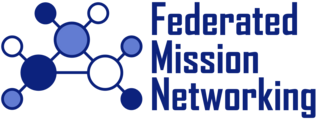Related Research Articles

Interoperability is a characteristic of a product or system to work with other products or systems. While the term was initially defined for information technology or systems engineering services to allow for information exchange, a broader definition takes into account social, political, and organizational factors that impact system-to-system performance.
The Open Group is a global consortium that seeks to "enable the achievement of business objectives" by developing "open, vendor-neutral technology standards and certifications." It has 900+ member organizations and provides a number of services, including strategy, management, innovation and research, standards, certification, and test development. It was established in 1996 when X/Open merged with the Open Software Foundation.
The Organization for the Advancement of Structured Information Standards is a nonprofit consortium that works on the development, convergence, and adoption of projects - both open standards and open source - for Computer security, blockchain, Internet of things (IoT), emergency management, cloud computing, legal data exchange, energy, content technologies, and other areas.
An open standard is a standard that is openly accessible and usable by anyone. It is also a common prerequisite that open standards use an open license that provides for extensibility. Typically, anybody can participate in their development due to their inherently open nature. There is no single definition, and interpretations vary with usage. Examples of open standards include the GSM, 4G, and 5G standards that allow most modern mobile phones to work world-wide.
A federated identity in information technology is the means of linking a person's electronic identity and attributes, stored across multiple distinct identity management systems.

The Department of Defense Architecture Framework (DoDAF) is an architecture framework for the United States Department of Defense (DoD) that provides visualization infrastructure for specific stakeholders concerns through viewpoints organized by various views. These views are artifacts for visualizing, understanding, and assimilating the broad scope and complexities of an architecture description through tabular, structural, behavioral, ontological, pictorial, temporal, graphical, probabilistic, or alternative conceptual means. The current release is DoDAF 2.02.
The British Ministry of Defence Architecture Framework (MODAF) was an architecture framework which defined a standardised way of conducting enterprise architecture, originally developed by the UK Ministry of Defence. It has since been replaced with the NATO Architecture Framework.

The Network Centric Operations Industry Consortium (NCOIC) is an international not-for-profit, chartered in the United States, whose goal is to facilitate the adoption of cross-domain interoperability standards. Formed in September 2004, the organization is composed of more than 50 members and advisors representing business, government organizations and academic institutions in 12 countries.
Semantic interoperability is the ability of computer systems to exchange data with unambiguous, shared meaning. Semantic interoperability is a requirement to enable machine computable logic, inferencing, knowledge discovery, and data federation between information systems.
Digital Earth is the name given to a concept by former US vice president Al Gore in 1998, describing a virtual representation of the Earth that is georeferenced and connected to the world's digital knowledge archives.
Geospatial metadata is a type of metadata applicable to geographic data and information. Such objects may be stored in a geographic information system (GIS) or may simply be documents, data-sets, images or other objects, services, or related items that exist in some other native environment but whose features may be appropriate to describe in a (geographic) metadata catalog.
A cross-domain solution (CDS) is an integrated information assurance system composed of specialized software, and sometimes hardware, that provides a controlled interface to manually or automatically enable and/or restrict the access or transfer of information between two or more security domains based on a predetermined security policy. CDSs are designed to enforce domain separation and typically include some form of content filtering, which is used to designate information that is unauthorized for transfer between security domains or levels of classification, such as between different military divisions, intelligence agencies, or other operations which depend on the timely sharing of potentially sensitive information.
The Emergency Data Exchange Language (EDXL) is a suite of XML-based messaging standards that facilitate emergency information sharing between government entities and the full range of emergency-related organizations. EDXL standardizes messaging formats for communications between these parties. EDXL was developed as a royalty-free standard by the OASIS International Open Standards Consortium.
Physical security information management (PSIM) is a category of software that provides a platform and applications created by middleware developers, designed to integrate multiple unconnected security applications and devices and control them through one comprehensive user interface. It collects and correlates events from existing disparate security devices and information systems to empower personnel to identify and proactively resolve situations. PSIM integration enables numerous organizational benefits, including increased control, improved situation awareness and management reporting. Ultimately, these solutions allow organizations to reduce costs through improved efficiency and to improve security through increased intelligence.

The Open Geospatial Consortium (OGC), an international voluntary consensus standards organization for geospatial content and location-based services, sensor web and Internet of Things, GIS data processing and data sharing. It originated in 1994 and involves more than 500 commercial, governmental, nonprofit and research organizations in a consensus process encouraging development and implementation of open standards.
The Open Group Future Airborne Capability Environment was formed in 2010 to define an open avionics environment for all military airborne platform types. Today, it is a real-time software-focused professional group made up of industry suppliers, customers, academia, and users. The FACE approach is a government-industry software standard and business strategy for acquisition of affordable software systems that promotes innovation and rapid integration of portable capabilities across programs. The FACE Consortium provides a vendor-neutral forum for industry and government to work together to develop and consolidate the open standards, best practices, guidance documents, and business strategy necessary to result in:

Nexor Limited is a privately held company based in Nottingham, providing products and services to safeguard government, defence and critical national infrastructure computer systems. It was originally known as X-Tel Services Limited.

The Industry IoT Consortium (IIC) (previously the Industrial Internet Consortium) is an open-member organization and a program of the Object Management Group (OMG). Founded by AT&T, Cisco, General Electric, IBM, and Intel in March 2014, with the stated goal "to deliver transformative business value to industry, organizations, and society by accelerating the adoption of a trustworthy internet of things".

Federated Mission Networking (FMN) is a significant initiative to help ensure the interoperability and operational effectiveness of the North Atlantic Treaty Organization. It is a key contribution to the Connected Forces Initiative, helping Allied and Partner forces to better communicate, train, and operate together. This includes the NATO Command Structure as well as the NATO Force Structure. The purpose of FMN is ultimately to support Command, Control, Communications, Computers, Intelligence, Surveillance and Reconnaissance (C4ISR) and decision-making in operations by enabling the rapid instantiation of mission networks. Including the NATO Command Structure, 37 nations have joined the FMN initiative as so-called "FMN Affiliates" and work together under the FMN Framework Process to coordinate the design, development, and delivery of operational and technical capabilities required to conduct net-centric operations. Each development increment is referred to as an "FMN Spiral.". The respective requirements, architecture, standards, procedures, and technical instructions are documented in the so-called "FMN Spiral Specifications.". FMN Spiral Specifications are based on well-known standards and best practices, hence supported by most off-the-shelf products and vendor neutral. TACOMS standards and profiles specify a common, technology- and topology independent network interoperability layer for federated mission networks. There is also a rolling 10-year FMN Spiral Specification Roadmap of the envisioned future capabilities. At the same time, the Coalition Interoperability Assurance and Validation (CIAV) process ensures that current interoperability issues are being identified and fed back into FMN capability development.
Clinical data standards are used to store and communicate information related to healthcare so that its meaning is unambiguous. They are used in clinical practice, in activity analysis and finding, and in research and development.
References
- ↑ Slater, T. "Cross-Domain Interoperability", Network Centric Operations Industry Consortium - NCOIC, 2013
- ↑ Sartipi, et al "Cross-Domain Information and Service Interoperability", University of Ontario, 2008
- ↑ NCOIC "Geospatial Community Cloud Concept Demonstration", Network Centric Operations Industry Consortium, 2013